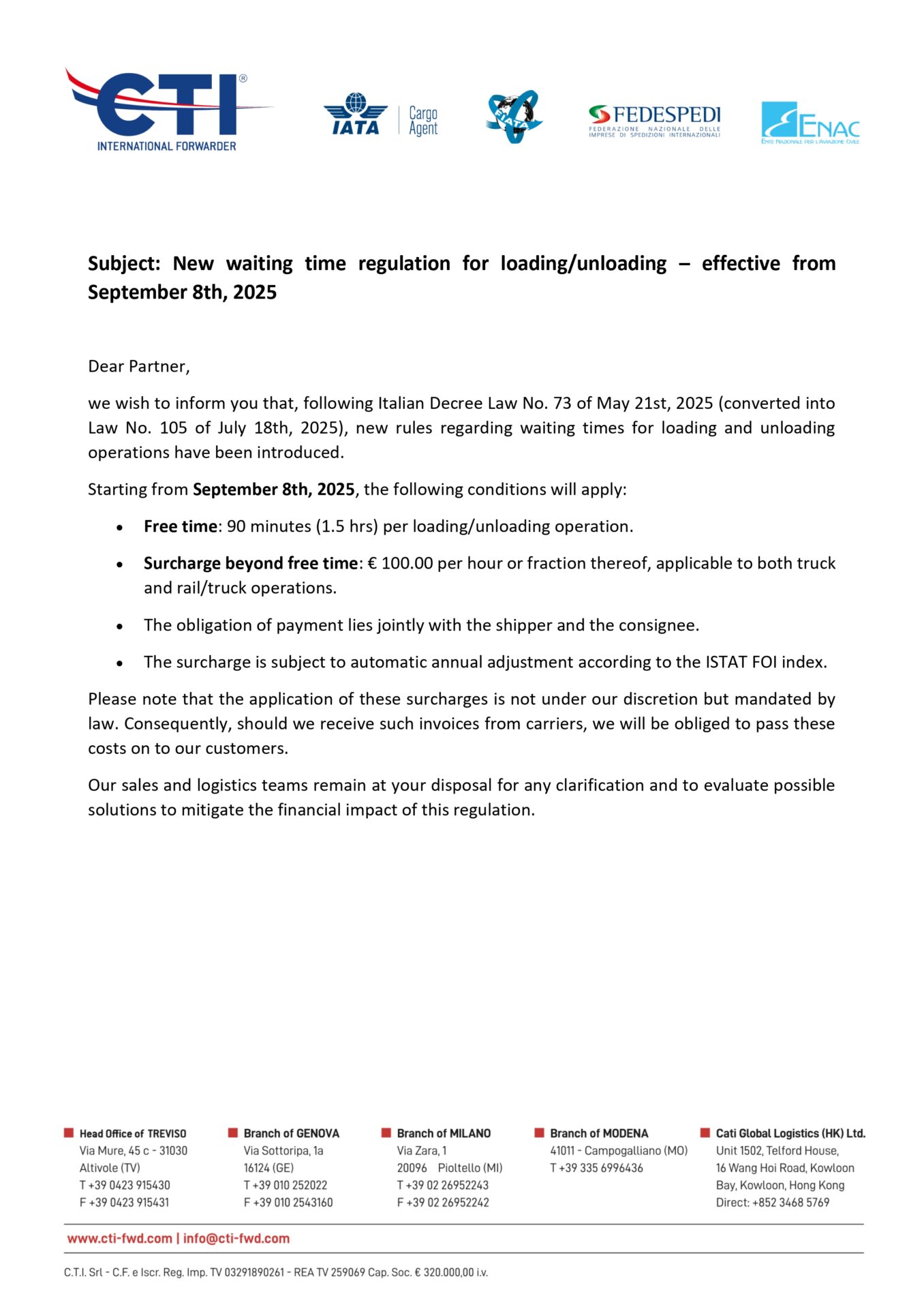As of 21 May 2025, the so-called “Infrastructure Decree 2025” (Decree-Law 73/2025) is in force, later converted with amendments into Law No. 105 of 18 July 2025. The package addresses road haulage, ports, motorway concessions and governance tools for the sector. For those operating in international logistics, the most impactful change concerns waiting times at loading/unloading and the related compensation, but it is not the only element to consider.
So let’s start with what directly affects our customers.
The new conditions
From 8 September, CTI will apply the new rules specifically on waiting times at loading and unloading. These provide that:
the free-time allowance will be 90 minutes for each operation;
beyond that threshold, compensation of €100 for every hour or fraction of an hour will be due;
payment liability is joint and several between the shipper and the loader.
the compensation will be adjusted annually according to the ISTAT FOI index.
The same rules apply, for the road legs, even when transport is in combined rail/truck mode.
These conditions stem directly from the legislation in force and are not at our discretion. Any excess costs will in fact be passed on to us by the carriers and, in turn, we will be forced to pass them on to our customers.
In this article, in addition to providing a broader overview of the decree’s contents, we will offer some advice on how to mitigate the economic impact of this legislation, while reiterating our availability for clarifications and tailored consulting.

The regulatory framework
Waiting times and compensation
Article 4 of Decree-Law 73/2025 rewrote Article 6-bis of Legislative Decree 286/2005: as anticipated in the previous paragraph, it now provides for a shorter free-time allowance for each operation; compensation of €100/hour (also for fractions) beyond the allowance; joint and several liability between shipper and loader; automatic adjustment of the compensation using the FOI index. The conversion law clarified that waiting times also include periods due to inactivity by the shipper, loader or consignee. In addition, compensation is due even if the time limits specified in the contract are exceeded, where this is evidenced by the documentation. Proof of arrival may be drawn from the company GPS or from the second-generation smart tachograph.
As for the adjustment, the index used is the consumer price index for blue- and white-collar households as defined by ISTAT and published monthly. In other words, the €100 amount is updated year by year in line with the FOI trend.
Payment terms and oversight
The 60-day payment framework for road transport contracts remains in place; in addition, paragraph 15-bis has been added to Article 83-bis of Decree-Law 112/2008: if failure to comply with deadlines also meets the conditions for “abuse of economic dependence”, the AGCM may intervene with formal warnings and sanctions. This makes administrative oversight of payment flows more stringent.
Other measures in the decree useful for international logistics
CIGAL dashboard
The conversion established, within the Ministry of Labour, CIGAL (Information Dashboard for the management of private procurement contracts in the logistics sector). Objective: to provide interested parties with information for verifying tax, social-security and labour compliance of contractors; enforcement bodies will populate a section dedicated to sanctions; Unioncamere will handle development and technical management. A ministerial decree will define its criteria and technical rules.
Ports and state property
Regarding maritime state-property concession fees, when the ISTAT index of wholesale market values is not available, the rules refer to the producer price index for industrial products; clarifications are also introduced on the Port Master Plan to ensure consistent application.
Exceptional transports
AINOP is integrated as the national reference infrastructure for planning and monitoring corridors for exceptional transports, with interoperability toward GIS, tracking systems and permitting platforms.
Motorway concessions
The law intervenes in the regime, referencing the ART tariff system and setting out procedural measures for updating the PEFs and the concession agreements.
How to prepare with CTI to minimize waits and charges
First and foremost, it is advisable to recalibrate loading/unloading windows and formalize specific SLAs on bay assignment times and site access times, also specifying how they will be measured (gate-in/gate-out timestamps, POD, GPS/tachograph data). For example, for shipments with volumes concentrated in a few hours, it is appropriate to adopt a slot-booking system with priorities and no-show rules.
Similarly, in intermodal flows it is necessary to synchronize rail-terminal slots with the first/last mile by road so as not to exceed the allowance on the road legs.
On the administrative side, it is useful to realign accounting and payment-schedule processes in light of the new paragraph 15-bis and possible AGCM action, to prevent disputes along the supply chain.
CTI remains available for any clarification and to evaluate, together, solutions to cushion the effect of these changes.










